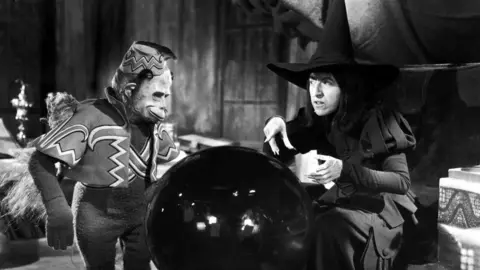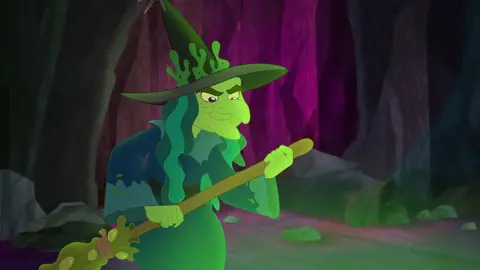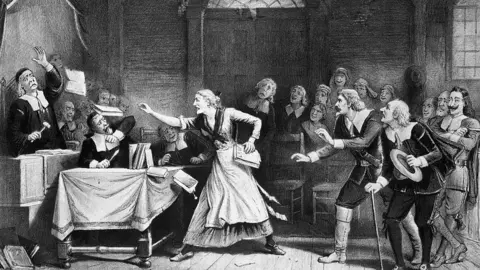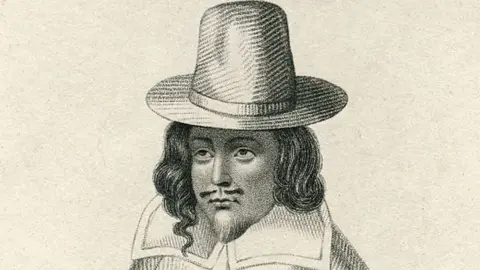Witch hunts: Why were so few 'witches' killed in Wales?
 Getty Images
Getty ImagesBritain has a long and bloody history of burning people accused of witchcraft at the stake.
About 4,000 were sent to their death in Scotland and 1,000 in England, but curiously just five were killed in Wales.
In his new book, author and historian Phil Carradice tries to unpack this anomaly and finds several explanations.
He believes it is at least in part down to the Welsh language.
"Very few examiners or judges spoke Welsh," said Phil, from Eglwys-Brewis, Vale of Glamorgan.
He also believes it could be explained by many of Wales' small, rural communities being so reliant on their local wise women.
"They made potions and charms and were an accepted part of the community," he said.
 Getty Images
Getty Images"There were no doctors, no hospitals... if you wanted help for yourself or your animals they would turn to their wise women."
Probably the most famous were the Physicians of Myddfai, a succession of herbalists who lived and worked in and around the Carmarthenshire village of Myddfai from the 13th Century.
Across the rest of the world killing "witches" was big business - from 1450 to 1700 in Europe alone about 35,000 people, mainly women, were hanged or burned at the stake after being accused of witchcraft.
Phil said the modern-day portrayals of witches in books and films - from the Wicked Witch of the West to Harry Potter's Hermione Granger - sometimes means this much darker, macabre history is forgotten.
"Disney has a lot to answer for... Harry Potter doesn't help... but kids need to know the other bits as well," said Phil.
"Women in the Middle Ages were abused, there's no other word for it."
Phil has written over 20 books but said researching his latest - Witches and Witch Hunts Through the Ages - left him feeling particularly uneasy.
"It frightened the living daylights out of me," he said.
"Consider burning people at the stake, it's horrendous."
So what motivated people to persecute these women?
"It's misogyny and it's also greed," he said.
He said accusing unmarried women or widows of being a witch was a sure-fire way of getting her locked up, making it easy to steal her assets.
"We had men - and it was men - who thought 'I want that house, I want that land, I want that property', and so how do they do it? [By saying] 'you're a witch', and straight away you're arrested on that one person's say, you're put into jail to await trial and while you're awaiting trial somebody steals your land."
The witch trials that are perhaps best known are the infamous Salem witch trials that took place in Massachusetts, USA, between February 1692 and May 1693.
More than 200 people were accused, 30 found guilty, 19 of whom were executed by hanging. Of those killed fourteen were women and five men.
 Getty Images
Getty ImagesBack in the UK it was Henry VIII who first defined witchcraft as a crime punishable by death in 1542.
But the most notorious royal witch-hunter of all time was James VI of Scotland, who went on to become James I of England.
"He was a rampant witch hunter," said Phil.
He and his Danish bride Anne encountered a dangerous storm during a voyage across the North Sea and became convinced they had been personally targeted by witches who conjured to try to kill them.
He published a book on the subject, Daemonologie, and in 1604 passed a second witchcraft act.
Decades later, with public anxiety about witchcraft still growing, lawyer Matthew Hopkins emerged.
Calling himself Witch-Finder General, Hopkins claimed to be officially commissioned by Parliament to uncover and prosecute witches.
He and his associates are believed to have been responsible for the deaths of 300 women accused of witchcraft in England between 1644 and 1646.
 Getty Images
Getty ImagesThe last person in Britain to be tried and executed for witchcraft was Janet Horne, who was burned at the stake in Dornoch, Scotland in 1727.
The facts are scant, even her name is one often given to witches in Scottish folklore, but it is thought she had a daughter who was born with a deformed hand.
Almost a decade later in 1736, Parliament passed an act repealing the laws against witchcraft but imposed fines or imprisonment on people who claimed to be able to use magical powers.
That act was repealed in 1951 by the Fraudulent Mediums Act, which in turn was repealed in 2008.
 Getty Images
Getty ImagesWitch hunting may be history in the UK but continues to this day in some other parts of the world.
From 2010 to 2021, more than 1,500 people were killed in India after accusations of witchcraft, according to the National Crime Records Bureau.
In northern Ghana hundreds of women accused of witchcraft by relatives or members of their community are living in so-called witch camps after fleeing or being banished from their homes.
"The reality is there are people out there being persecuted, being condemned, being horribly killed," said Phil.
"We need to do something about what's going on but we're frightened."
